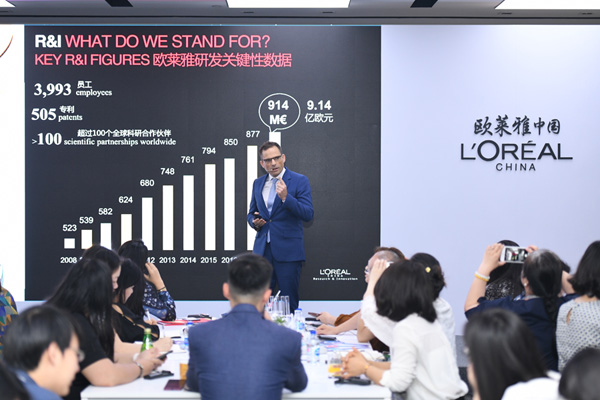
Maxime De Boni, vice-president of R&I at L'Oreal China. (Photo provided to China Daily)
L'Oreal opened its China Research and Innovation Center to the media and key opinion leaders in Shanghai recently, introducing its new discoveries about the important links between the skin's microbiome and skin health.
The largest beauty group in the world, L'Oreal established its China research and innovation center in 2005, and it has developed into the company's largest R&I center in the Asia-Pacific region. The cosmetic company has six R&I centers worldwide.
Maxime De Boni, vice-president of R&I at L'Oreal China, led journalists and KOLs from all over China around the offices and laboratories located in the Pudong new area of Shanghai.
According to Tarun Chopra, head of the L'Oreal Asia Microbiome Center of Excellence, skin microbiome research is a key field of research, which will "set off another revolution in global cosmetic innovation that will help us break through efficacy limits through a completely fresh perspective".
The microbiome refers to the totality of micro organisms and their collective genetic material present in or on the human body or another environment, Chopra explains.
He believes that the skin's microbiome is a new cross-disciplinary area standing at the crossroads of cosmetics, biology, medicine and other fields of research.
L'Oreal is one of the earliest and largest investors in this field among cosmetic companies globally.
On June 25, Lancome, brand under L'Oreal held a skincare symposium in Paris to introduce their latest achievement on skin microbiome, as well as launching their updated Advanced Genifique which uses the latest technique.
Speaking about the future, De Boni says: "We are confident in leading the way to making the microbiome a huge opportunity for consumers and for the cosmetic industry.
"We are also looking forward to launching new products developed with the latest research results as soon as possible in China," though he declined to give a specific timeline.
China has been an important heartland for the group's skin microbiome research, De Boni says. "Chinese consumers will be more influential in the global market, as they have high sensitivity for beauty and trends and strong curiosity about skin care and cosmetic science." L'Oreal has done extensive studies on Chinese consumers believing that "everything we can capture from the understanding of Chinese consumers will be influential for the world of beauty".
The China R&I Center has played a leading part in the company's research on problems such as common dandruff and pollution exposure, De Boni says. And the research achievements are used worldwide.
Some products designed for Chinese consumers, such as a new facial mask for aging and sensitivity, is popular not only in the Chinese market, but also in Southeast Asia, Europe and even the US market.
"Identifying the relationship between the microbiome and environmental factors is a major challenge in today's skin microbiome research, and pollution exposure studies led by the Chinese team are expected to provide insight that could lead to breakthroughs," he says.
L'Oreal has been working on the microbiome for more than 15 years, with its R&I center carrying out over 57 clinical studies in 12 domains and publishing 45 papers and scientific publications on the skin's microbiome for dandruff, aging, atopic dermatitis and pollution.
The L'Oreal China R&I center has also collaborated with the Shanghai Pasteur Institute of the China Academy of Sciences and other dermatologists in skin microbiome research.
According to Professor Liu Wei, deputy president of the Chinese Dermatologists Association, "this is an era of idealism for skin microbiome research … and we believe that collaboration will help us break through technical barriers faster and find ways to get stable, live probiotics, and keep them in a form that allows them to recover their efficiency when applied to the skin.
"I hope that one day through our 'orders' to the skin microbiome, we can automatically maintain the skin ecosystem's dynamic stability and play a more exemplary role in promoting the long-term health of the skin," he says.


